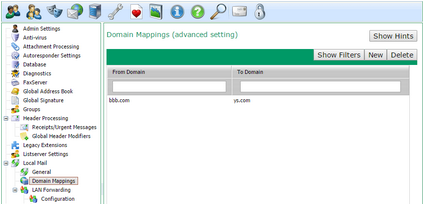
To get to this page, go to Settings → Local Mail → Domain Mappings
This page is for an advanced setting. It is rarely needed, and in most cases where you think it might be needed, it probably isn't. Really.
Generally the only time it is needed is if you have a legacy configuration where you have a different email domain inside your company than is used from outside to contact you.
For instance, you may use the fictional domain 'internal' inside your company, and the real domain 'example.com' outside. So, to email a local user 'fred' from another local user, you would send to 'fred@internal', but to email the same user from outside your company you would use 'fred@example.com'. In this case you would set up your internal email client to know that your email address is something like 'bob@internal', so that when internal users reply to your messages they will go to the @internal address. Obviously this causes problems if you send outgoing mail, the external recipient will see the reply address as being 'bob@internal' rather than 'bob@example.com'.
You could create two 'identities' in your email client and choose the appropriate one when sending messages, but mistakes may happen and you may occasionally use the wrong address.
That is what Domain Mappings are to help with.
To help with the above example situation, you would press New to add a new Domain Mapping, then in the From Domain column, put 'internal', and the the To Domain column, put 'example.com'.
Then, when you send a message, VPOP3 will look through the message headers and change any email addresses in the From Domain to be in the To Domain. This includes the To and Cc etc as well as the From and Reply-To headers, so if bob@internal sends a message to kate@customer.com and CCs fred@internal, Kate will see that it came from bob@example.com and was sent to kate@customer.com and Ccd to fred@example.com.
If you are setting up a new system, we strongly recommend that you do NOT try to be clever and use this feature, it will cause confusion and extra complexity. Instead, simply use the same email addresses internally and publicly.

